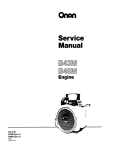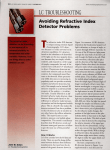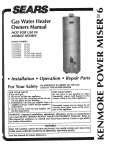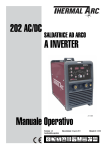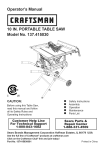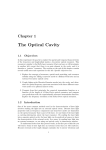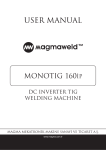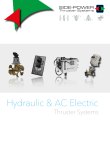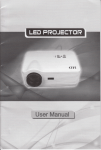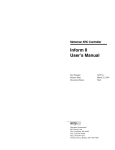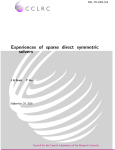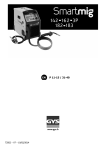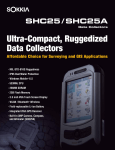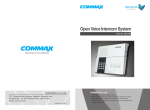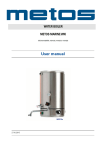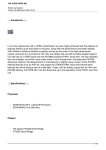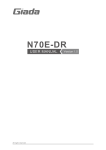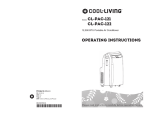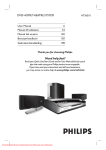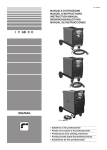Download 200HF User Manual
Transcript
INSTRUCTION MANUAL FUSION 151 HF FUSION 151 PHF FUSION 200 HF FUSION 200 PHF Issue 02: Sept 2006 Made in Britain CAUTION: Ensure the operator of this equipment reads this information. Additional copies can be obtained from your equipment supplier. If you are not fully conversant with the principles of operation and safe working practices for arc welding, we recommend that you read the HSE Booklet HSG204 (Health & Safety in Arc Welding). Do not attempt to install or operate this equipment until you have read and fully understood the contents of this manual. If you do not fully understand any instruction, contact your supplier for further information and advice before attempting any welding or installation procedure. 24pp A5 Instruction Manual.indd 1 28/9/06 3:33:09 pm 24pp A5 Instruction Manual.indd 2 28/9/06 3:33:09 pm INDEX Subject Page EQUIPMENT INSTALLATION 1 DESCRIPTION OF CONTROLS 2 EQUIPMENT SPECIFICATIONS 3 MMA (Stick) WELDING FUNCTION & OPERATION 4 MMA (Stick) WELDING REMOTE CONTROL 4 HF TIG WELDING FUNCTION & OPERATION 5-6 LIFT TIG WELDING FUNCTION & OPERATION 7 TIG WELDING REMOTE CONTROL 7 TIG SPOT WELDING FUNCTION & OPERATION 8 REMOTE CONTROL CONNECTIONS 9 FUNCTION GUIDE 10-11 MMA (STICK) WELDING GUIDE 12 TIG WELDING GUIDE 13 INSULATION & PAT TESTING 14-15 WARRANTY INSTRUCTION 16-17 CARE & MAINTENANCE 18 TROUBLESHOOTING GUIDE 19 NOTICE: Failure to adhere to the advice and instruction given in this manual or to the implementation of the National/International Safety in the Workplace Regulations could render the operator liable to danger that could be avoided. Inverter Fusion Limited takes no responsibility for any accident that could occur from non-compliance of any Safety Advice or the relevant Safety Standards. 24pp A5 Instruction Manual.indd 3 28/9/06 3:33:09 pm INSTALLATION Correct Installation can contribute materially to the satisfactory working of the welding inverter. Each step in this section should be studied and adhered to as closely as possible. A INSPECTION & PLACEMENT 1. Remove all packaging and inspect for any evidence of damage. Immediately notify the supplier of any defects. 2. Check the unit for any loose parts. Ensure that air louvers are free from any packaging material that could obstruct the airflow through the machine. 3. The components in the inverter operate at high temperatures and it is important that the fan input and output louvers are not obstructed. Locate the unit in an open area allowing air to circulate freely around the machine. The area around the machine should be relatively free from dust and excessive heat. 4. Complete a risk assessment of the area to ensure that no danger to the Health & Safety of the operator or any other person can be incurred during the equipment operation. Consideration to noxious gases, fume, arc glare, fire risk and moisture should also be fully considered. B PRIMARY ELECTRICAL INPUT CONNECTION WARNING All possible measures should be taken to provide maximum protection against electrical shock. Ensure the mains power is isolated before making any primary connections. 1. Ensure that an adequate mains power supply is available with a correct fuse rating, to supply the machine at the duty cycle the operator requires to work within. 2. The machine is supplied with a two metre 3 core input power cable for connection to a suitable single-phase power supply. The earth conductor in the power cable must at all times be secured to ground earth. 3. Fit and use only plugs or circuit breakers that are designed for the level of primary input voltage and input current required for the safe operation of the machine. 4. Extension cables may result in excessive voltage drops that will influence the welding output of the machine. Use only industrial grade extension cables and ensure that the cable conductor sizes are relevant to the required current draw. C SECONDARY (WELDING OUTPUT) CONNECTIONS WARNING Before making any connections to the welding output terminals of the machine, ensure that the mains power to the machine is switched off and the power cable is unplugged. 1. The machine is fitted with 35mm Dix style output connections; always use connection plugs of a compatible size. Ensure that the connection plugs are free from damage and are fully locked into the output terminals. Loose or damaged connections will cause the plugs to overheat and will cause damage to the machine. 11 24pp A5 Instruction Manual.indd 4 28/9/06 3:33:09 pm DESCRIPTION OF CONTROLS FUSION HF & PHF Front View CONTROL FUNCTION F1 Current Adjustment F2 Output Display Meter F3 LED Function Display F4 Positive Output Dix Socket F5 Negative Output Dix Socket F6 Mains Power On/Off Switch F7 Mode Selector TIG & MMA F8 Program Selection Control F9 Program LCD Menu Display F10 Gas Output Connection F11 Gas Input Connection F12 Remote Control Socket 3 Wire ** F13 Remote Control Socket 5 Wire** FUSION HF & PHF Rear View LED 1 LED 2 LED 3 LED 4 LED 5 LED 6 Mains Power Indicator MMA Mode Indicator Lift TIG Indicator HF TIG Indicator Meter Hold Indicator Overheat Indicator Torch Switch Plug Connection Connect the torch switch leads to pins 1 & 2 in the remote connection plug supplied. Remote Current Plug Connection Refer to the diagram on Page 14 for connection instructions. NOTE: **The equipment is supplied as standard with a 5-wire remote control receptacle for torch switching and current control. A 3-wire remote control option is available upon request. It is not possible to fit both 3 & 5 wire options simultaneously. Dead Man Safety Feature. A dead man safety feature is installed in the HF & PHF units to reduce the danger from the torch arcing accidentally on surfaces other than the welding fixture. In the TIG Welding Mode, if the arc fails to establish after 3 seconds (Not including any pre-gas time if selected) the unit is programmed to switch off. To re-start the arc release the torch switch and recommence the welding start sequence. If at any time during the TIG welding sequence of operation the arc is accidentally broken the machine is programmed to switch off. If a down-slope time has been selected the machine will remain inoperative until both the down slope, crater and post gas times as selected have expired. 2 2 24pp A5 Instruction Manual.indd 5 28/9/06 3:33:10 pm SPECIFICATION DETAIL EQUIPMENT P/No. 000633 P/No. 000634 P/No. 000485 P/No. 000200 Fusion 151 HF Fusion 151 PHF Fusion 200 HF Fusion 200 PHF 110V- 150 Amp MMA/LT/HF TIG Inverter. 110V - 150 Amp MMA/LT/PHF TIG Inverter. 230V - 200 Amp MMA/LT/HF TIG Inverter. 230V - 200 Amp MMA/LT/PHF TIG Inverter. OPTIONAL ACCESSORIES P/No. 000537 150 Amp GP17 Air Cooled TIG Welding Torch, Fitted with 4 Metre Hose Assembly, Plugs & Handle Mounted On/Off Switch. P/No. 000561 150 Amp GP17R Air Cooled TIG Welding Torch, Fitted with 4 Metre Hose Assembly, Plugs & Handle Mounted On/Off Switch & Thumb Wheel for Remote Current Control. P/No. 000111 GP17 Torch Accessory Kit. Including Long Back Cap, Collet Bodies, Collets and Tungsten Electrodes. P/No. 000320 Footswitch for Remote Current Control & On/ff Switching, Fitted with 3 Metre Cable & Plug. P/No. 000313 Argon Gas Supply Hose, 3 Metre Fitted with 1/43/8" BSP Fittings. P/No. 000080 Electrode Holder, Fitted With 3 Metre Power Cable & 35mm Male Dix Plug. P/No. 000079 Earth Clamp, Fitted With 3 Metre Power Cable & 35mm Male Dix Plug. SPECIFICATIONS Fusion 151 HF 110V AC Fusion 151 PHF 110V AC Fusion 200 HF 230V AC Fusion 200 PHF 230V AC 32A Slow Blow 5KVA 7KVA 22A Slow Blow 22A Slow Blow Power Transformer Rating Power Generator Rating 32A Slow Blow 5KVA 7KVA 7KVA 7KVA MMA Power Output Amps TIG Power Output Amps 100% Duty Cycle MMA Amps 100% Duty Cycle TIG Amps 20-120 10-150 120 150 20-120 10-150 120 150 20-180 5-200 160 180 20-180 5-200 160 180 Max Open Circuit Voltage Power Factor @ 100% Efficiency® 100% Enclosure Class Application Class Ambient Temperature 92 Volts 0.71 0.96 IP 23 S 92 Volts 92 Volts 0.71 0.71 0.96 0.96 IP 23 IP 23 S S -10 <>+40 Degrees C Input Volts 50/60Hz +/-15% Typical Input Fuse Rating Cooling Method - 92 Volts 0.71 0.96 IP 23 S Forced Fan Standard Warranty Weight Dimensions - IEC 60974 CE Marked 9 Kg 24 Months Full Parts & Labour 9 Kg 9 Kg L 365mm x H 360mm x W 220mm 9 Kg 33 24pp A5 Instruction Manual.indd 6 28/9/06 3:33:10 pm MMA (Stick) WELDING FUNCTION & OPERATION 1. GENERAL The Fusion range of digital welding inverters is designed to operate at optimum performance when supplied with a suitable mains input supply, as specified. 2. MAINS POWER CONNECTION On applying power to the unit, the inverter will perform a self-setting check. This will be indicated by all displays briefly flashing on then off. Following this, LED 1 will stay lit to indicate that mains power is present and the unit is ready for operation. 3. (1) MMA (STICK) WELDING SET UP (Panel Control) Connect the electrode & work return supply cables into the Dix sockets (F4 & F5) Check the consumable manufacturers specification for the correct polarity required. (2) Set the mains power switch (F6) to the on position. The welding output meter (F2) will light up as will the LCD display (F9). The selected welding mode LED (MMA/TIG) will also be lit in the LED display (F3). (3) Ensure that at no time the electrode holder and work return clamp come into contact as this could cause the machine to arc and could result in personal injury. (4) Rotate the mode selection knob (F7) in either direction until LED 2 is illuminated and 'MMA MODE' is displayed in the menu display window (F9). (5) Select the output current required by rotating the control knob (F1). The selected output will be displayed in the digital output meter (F2). (6) Using a swift motion, Rotate control knob (F8) clockwise until the text 'REMOTE CURRENT is displayed in the window (F9). Rotate control knob (F1) in an anti clockwise direction until the text in window (F9) reads 'PANEL CONTROL'. (7) Using the correct safety equipment to protect the body and eyes fit an electrode in the holder and connect the work return cable to the work piece. Strike the electrode on the work piece to establish the welding arc. To end the welding application, quickly lift the electrode away from the work piece. (8) At the end of the weld, LED 5 will be illuminated, indicating that the welding output meter hold feature is activated. (The hold feature displays the last welding current used) This will re-set on welding re-start or if the output current is adjusted. (9) When the welding application is completed, place the mains switch (F6) in the off position and disconnect the unit from the mains power supply. 4. (1) MMA (STICK) WELDING SET UP (Remote Current Control) Connect the remote current control device into the receptacle (F12/F13). Follow the MMA set up procedure as described in paragraph 3 (1 to 5). (2) Rotate control knob (F8) until the text 'REMOTE CURRENT' is displayed in the window (F9). Rotate control knob (F1) in a clockwise direction so that the text in window (F9) reads either 'FOOT CONTROL' or TORCH CONTROL' as required for the type of remote control device to be used. (3) The welding current is now adjustable with the remote control device between the machines minimum output and the main welding current output as selected on the digital meter (F2). Complete the welding process as detailed in paragraph 3 (7 to 9). 4 24pp A5 Instruction Manual.indd 7 28/9/06 3:33:11 pm TIG WELDING FUNCTION & OPERATION 5. (1) HF TIG WELDING SET UP (Panel Control) Connect the work return cable into the positive Dix socket (F4). Connect the TIG welding torch (use a torch TIG adapter if required) into the negative Dix socket (F5). Attach the torch gas supply hose to the shielding gas outlet (F10). Screw the torch switching control plug into the remote control socket (F13). Fit the shielding gas supply hose to the gas inlet connection (F11). Adjust the shielding gas inlet pressure and flow as required. (2) Set the mains power switch (F6) to the on position. The welding output meter (F2) will light up as will the LCD display (F9). The welding mode as selected will also be shown on the LED display (F3) and in the LCD menu display (F9). (3) Rotate the mode selection knob (F7) in either direction until LED 3 is illuminated and 'TIG MODE' is showing in the menu display window (F9). At this point LED 4 may also be illuminated indicating that the HF start function is selected. (4) Select the main welding output current required by rotating the control knob (F1). The selected output will be displayed on the digital output meter (F2). (5) The menu selection control knob (F8) is used to move through the welding function menu. Using a swift motion rotate the menu selection control knob (F8) clockwise approximately 90 Degrees. The text in the display window (F9) will change and display the next function in the menu. By repeating this operation the complete menu sequence can be stepped through and welding parameter adjustments can be made as required using the control knob (F1). The selected menu function will be displayed for twenty seconds, after which the display widow (F9) will return to a datum point and display TIG MODE'. At any time during the menu set up, the display can be signalled to return to the datum point by pressing and releasing the torch on/off switch. The selection control knob can be rotated in either direction to move both forward and backward through the welding sequence program. (6) The menu display function and operations as described in the following instructions (7),(8),(10),(11),(12),(13,(15) & (16) are only available on the Fusion PHF models. (7) Rotate the control knob (F8) clockwise until the text 'PRE GAS TIME' is displayed in window (F9). Rotate control knob (F1) to select the required pre-gas time. (8) Rotate the control knob (F8) clockwise until the text 'START CURRENT is displayed in window (F9). Rotate control knob (F1) to select the required start current amps. (9) Rotate the control knob (F8) clockwise until the text 'HF START is displayed in window (F9). Rotate control knob (F1) to switch the HF start on. When the HF start is switched on the LED 4 will be illuminated. When the HF start is switched off the machine will operate in the Lift TIG mode. The Lift TIG welding mode and operation is explained in section (5) page (7). (10) Rotate the control knob (F8) clockwise until the text 'UP SLOPE TIME' is displayed in window (F9). Rotate control knob (F1) to select the required up slope time. (11) Rotate the control knob (F8) clockwise until the text 'PULSE CURRENT is displayed in window (F9). Rotate control knob (F1) to select the required pulse base (background) current amps required. Rotate the control knob (F8) anticlockwise to switch the pulse mode off. If the pulse current is adjusted to display off, the pulse timers described in the following section will be disenabled. (12) Rotate the control knob (F8) clockwise until the text 'BASE TIME' is displayed in window (F9). Rotate control knob (F1) to select the required base pulse time. 24pp A5 Instruction Manual.indd 8 55 28/9/06 3:33:11 pm TIG WELDING FUNCTION & OPERATION (13) Rotate the control knob (F8) clockwise until the text 'PULSE TIME' is displayed in window (F9). Rotate control knob (F1) to select the required high pulse time. (14) Rotate the control knob (F8) clockwise until the text 'DOWN SLOPE TIME' is displayed in window (F9). Rotate control knob (F1) to select the required slope down time. (15) Rotate the control knob (F8) clockwise until the text 'CRATER CURRENT is displayed in window (F9). Rotate control knob (F1) to select the required crater amps level. (16) Rotate the control knob (F8) clockwise until the text 'CRATER TIME' is displayed in window (F9). Rotate control knob (F1) to select the required crater current time. (17) Rotate the control knob (F8) clockwise until the text 'POST GAS' is displayed in window (F9). Rotate control knob (F1) to select the required post gas time. (18) Rotate the control knob (F8) clockwise until the text 'TIG SWITCH' is displayed in window (F9). Rotate control knob (F1) to select either 2T or 4T touch operation. In 2T operation the weld sequence will start and stop as selected when the torch switch is depressed and released. In 4T operation when the torch switch is depressed the arc will strike in and hold at the start current level, when the switch is released the arc will upslope to the main welding current level. When the switch is again depressed the arc will down-slope and hold at the crater current level, when the switch is released the arc will switch off. If the torch switch is released during the down slope time the weld will switch of at that point. (19) Rotate control knob (F8) clockwise until the text 'REMOTE CURRENT' is displayed in the window (F9). Rotate control knob (F1) in an anticlockwise direction so that the text in window (F9) reads 'PANEL CONTROL' (20) It is not necessary to adjust the welding sequence menu parameters in the order as described. Any parameter can be individually adjusted by rotating the control knob (F8) in either direction until the required area of the program is displayed in the window (F9) and the adjustment made as required using control knob (F1) (21) When all required parameters have been set in the sequence menu program, the unit will store the data until any further adjustment is made. The data will also be stored ready for future use even when the mains power is switched off. (22) Using the correct safety equipment to protect both the body and the eyes, hold the torch at an angle of 45 degrees so that the tungsten electrode is approximately 2-3 mm away from the work piece. Depress the torch switch, the gas will start to flow and a HF spark will jump from the tungsten to initiate the welding arc. (23) Once the welding arc is established the unit will operate as programmed. At any time in the 2T switch mode the welding arc can be stopped by releasing the torch switch. In the 4T switch mode the arc is stopped by pressing and releasing the torch switch. (24) Complete the welding application as required making output and control parameter adjustments as necessary. (25) If at any time the welding arc is broken prior to signalling the machine to switch off, the dead man device installed in the machine will be activated and it will not be possible to re-strike the arc until the post flow gas time has completed. (26) When the welding application is completed, turn the power switch (F6) to the off position and disconnect the unit from the mains power supply. 6 6 24pp A5 Instruction Manual.indd 9 28/9/06 3:33:11 pm TIG WELDING FUNCTION & OPERATION 5. (1) LIFT TIG WELDING SET UP (Panel Control) To use the machine for LIFT TIG applications follow the instruction as described and detailed for' HF TIG Welding Set Up' in paragraphs (1) through to (8) (2) Rotate the control knob (F8) clockwise until the text 'HF START is displayed in window (F9). Rotate control knob (F1) anticlockwise to switch the HF start off. When the HF start is switched off the LED 4 will not be illuminated. The machine will now operate in a Lift TIG mode and no HF will be present at the start of the welding sequence. (3) Continue to complete the program sequence set up as described for 'HF TIG Welding Set Up' In section 4 paragraphs (10) through to (21) (4) Using the correct safety equipment to protect the body and the eyes, rest the torch gas shroud on the work piece at an angle of 45 degrees to the work piece. Depress the torch switch, this will start the shielding gas to flow, still resting the torch gas shield on the work piece, rotate the torch forward until the tungsten electrode touches the work piece, then lift gently away approximately 4mm. This will cause the arc to establish and the welding application can be commenced. The method of starting the arc in the Lift TIG mode requires that the electrode is made to momentary make contact with the work piece, practice will provide the individual operator with the best method of completing this task. (5) Complete the welding application and set up procedure as detailed in 'HF TIG Welding Set Up' in paragraphs (23) through to (26). 6. (1) TIG WELDING SET UP (Remote Current Control) Connect the remote current control device to be used into the receptacle (F12/F13) and complete the set up and operational instructions as detailed for HF TIG Welding Set-Up in paragraphs (1) through to (18). (2) Rotate control knob (F8) clockwise until the text 'REMOTE CURRENT' is displayed in the window (F9). Rotate control knob (F1) in either direction so that the text in window (F9) reads 'FOOT CONTROL' or TORCH CONTROL' (3) Complete the welding application and set up procedure as detailed in 'HF TIG Welding Set Up' in paragraphs (20) through to (26). (4) If 'FOOT CONTROL' is selected the machine will switch on and off when the foot switch is depressed and released. The welding output current will increase and decrease as the footswitch regulation is varied. Full depression of the footswitch will allow up to 99% of the welding current value as selected on the (F2) display meter. If the 'FOOT CONTROL' option is selected then Start Current, Up-Slope Time, Down-Slope Time and Crater Current settings in the LCD window menu are disabled. The operator will have full control of all the functions via the remote control foot pedal device. (5) If TORCH CONTROL' is selected this will allow the main welding output current to be controlled from a remote current adjustment control device. The welding output current will increase and decrease as the remote regulation is varied and will allow variation of the welding output current value as selected on the (F2) display meter. The machine welding sequence will be switched On & Off as detailed in HF TIG Welding Set Up paragraph (18). When a remote current device is adjusted, the output current as selected will be displayed in the (F2) meter. All other available LCD menu options will be fully functional. 7 24pp A5 Instruction Manual.indd 10 7 28/9/06 3:33:12 pm TIG SPOT WELDING FUNCTION & OPERATION 7. (1) TIG SPOT WELDING The TIG SPOT welding menu function option is only available on the Fusion PHF models. (2) Connect the work return cable into the positive Dix socket (F4). Connect an appropriate TIG Spot Welding Torch (use a TIG torch adapter if required) into the negative Dix socket (F5). Attach the torch gas supply hose to the shielding gas outlet (F10). Screw the torch switch control plug into the remote control socket (F13). Fit the shielding gas supply hose to the gas inlet connection (F11). Adjust the shielding gas pressure and flow as required. (3) Set the mains power switch (F6) to the on position. The welding output meter (F2) will light up as will the LCD display (F9). (4) Rotate the mode selection knob (F7) in either direction until LED 3 is illuminated and 'SPOT MODE' is showing in the program display window (F9) At this point LED 4 will also be illuminated. (5) Select the main welding output current required by rotating the control knob (F1). The selected output will be displayed on the digital output meter (F2). (6) Rotate the control knob (F8) clockwise until the text 'PRE GAS TIME' is displayed in window (F9). Rotate control knob (F1) to select the required pre-gas time. (7) Rotate the control knob (F8) clockwise until the text 'SPOT TIME' is displayed in window (F9). Rotate control knob (F1) to select the required spot weld time. (8) Rotate the control knob (F8) clockwise until the text 'DOWN SLOPE TIME' is displayed in window (F9). Rotate control knob (F1) to select the required time. (9) Rotate the control knob (F8) clockwise until the text 'POST GAS' is displayed in window (F9). Rotate control knob (F1) to select the required post gas time. (10) It is not necessary to adjust the welding sequence parameters in the order as described. Any parameter can be individually adjusted by rotating the control knob (F8) in either direction until the required area of the program is displayed in the window (F9) and the adjustment made as required using control knob (F1). (11) Using the correct safety equipment to protect both the body and the eyes, position the spot welding torch as required. Depress the torch switch, the gas will start to flow and a HT spark will jump from the tungsten to initiate the welding arc. The arc will remain established to complete the spot welding time and down slope time as selected. Once the spot time is completed the post flow gas will operate for the time as programmed. (12) Complete the welding application as required making parameter adjustments as necessary. (13) When the welding application is completed, turn the power switch (F6) to the off position and disconnect the unit from the mains power supply. 8 8 24pp A5 Instruction Manual.indd 11 28/9/06 3:33:12 pm REMOTE CONTROL CONNECTION FIVE WIRE REMOTE CONTROL CONNECTION For 5-wire remote control connection, the remote control receptacle (F13) is installed as detailed. Any 5-wire remote control device should be connected as follows: TIG Torch Switch Pin 1...Trigger Switch Pin 2...Trigger Switch Pin 3...Not Used Pin 4...Pot Start (Bottom) Pin 5...Pot Wiper Pin 6...Pot End (Top) Pin 7...Ground The remote source for the control is ratio metric. Any potentiometer with a value between 1K & 10K Ohms can be used for the control. Remote Potentiometer current increase —>Ŷ THREE WIRE REMOTE CONTROL CONNECTION For 3-wire remote control connection, the remote control receptacle (F12) is installed as detailed. Any 3-wire remote control device should be connected as follows: Remote Potentiometer current Increase —> TIG Torch Switch Pin 1...Pot End (Top) & Pot Wiper Pin 2...Trigger Switch & Pot Start (Bottom) Pin 3...Not Used Pin 4...Not Used Pin 5...Not Used Pin 6...Trigger Switch Pin 7...Ground For 3-wire remote control connection a potentiometer value of 10K Ohms must be used. 9 24pp A5 Instruction Manual.indd 12 9 28/9/06 3:33:12 pm FUNCTION GUIDE Control Function Pre-Flow Gas Time Controls the length of time that the shielding gas flows before the arc is started. Controls the power output amps that the arc will start and strike in at. Allows sufficient shielding gas to be present in the weld area to avoid any contamination in the welding puddle. The size and type of tungsten electrode used will determine the optimum start current level. 1.0mm electrodes will require a minimum of 10amps, 2.4mm 20amps and for larger sizes the current would be increased as required. Lift TIG Start Operation Provides a method of starting the arc without the use of HF. Allows the arc to be established by touching the electrode on the work piece and then lifting away avoiding the necessity to scratch the electrode and reduces the potential for the electrode to stick down and contaminate. HFTIG Start Operation Provides method of starting the arc using a high frequency generated spark. Allows the arc to be established without the necessity of touching the electrode on the work piece. A high voltage spark jumps from the electrode to the work piece, ionising the shielding gas allowing the arc to establish. Up-Slope Timer Controls the time the arc takes to ramp up from the start current setting to the selected main welding output current. Allows the welding current to be gently increased in the weld puddle. Pulse Mode Selection Allows a controllable high current level to be used for the welding application without the risk of burn through. It also allows for a wide weld bead to be completed on thin gauge material. Base Pulse Time If turned to minimum the pulse is switched off. If a current level is selected the machine will pulse between the level selected and the current level displayed on the main amp display meter. Controls the time that the base current selected is operational. Peak Pulse Time Controls the time that the peak / main current selected is operational. Start Current Control Explanation Allows the base / low current pulse time to be adjusted so that burn through or excessive current is not used in the welding application. Allows the main / high pulse current time to be adjusted so that optimum weld penetration is maintained during the welding application. DownSlope Time Controls the time the arc takes to ramp down from the main welding current to the crater / final current if selected or to switch off. Allows the weld current to be gently reduced as required allowing weld overlaps to be completed without excess weld bead material build up. Crater Current Control When a crater current level is selected the weld output will ramp down to the selected level at the end of the weld sequence. To maintain the arc at the end of the weld sequence allowing welds to be completed right up to the edge of the component. 10 10 24pp A5 Instruction Manual.indd 13 28/9/06 3:33:13 pm FUNCTION GUIDE Control Function Explanation Crater Current Time This controls the time that the arc will be maintained at the selected crater current level. As described for Crater Control. Post-Flow Gas Time Controls the length of time the shielding gas flows after the arc is switched off.. To prevent contamination of the weld puddle and to also allow the tungsten and welding torch to cool down. 2 Touch Torch Control Signals the machine to start and end the welding sequence. When the torch switch is depressed the weld sequence will begin. When the switch is released the weld sequence will be signalled to end. 4 Touch Torch Control Signals the machine to start and step through the welding sequence. Allows for easy control at the start and end of the welding application. Remote Control Provides method of adjusting the welding current output using either a foot or hand operated device. The remote control device will allow 0-100% adjustment of the current as selected on the main current display. FUNCTION SEQUENCE 11 24pp A5 Instruction Manual.indd 14 11 28/9/06 3:33:13 pm MMA (STICK) WELDING GUIDE MMA(STICK) (STICK) WELDING GUIDE MMA (STICK) WELDING GUIDEGUIDE MMA WELDING The following notes are aimed at providing the operator with a basic overview of MMA welding Thefollowing following notes areat aimed providing theoperator operator withaoverview abasic basic overview MMAwelding welding The following notes aimed providing theoroperator with of a basic of welding MMAofof welding The notes aimed atatproviding the with overview MMA techniques andare do notare provide instruction explanation welding theory or practice. techniques andprovide donot notprovide provideinstruction instruction explanation welding theory welding practice. techniques and do and not instruction or explanation of welding theory or welding practice. techniques do ororexplanation ofofwelding theory ororwelding practice. PREPERATION PREPERATION PREPERATION AllPREPERATION materials to be welded should be clean and free from rust and grease. The joint to be welded Allmaterials materials be weldedshould should be clean and free from rust andgrease. grease. The joint bewelded welded All materials to be welded should be clean and free from rust andrust grease. The joint to joint be welded All totobe welded be clean and free from and The totobe should be suitably prepared and clamped in position. should besuitably suitably prepared andclamped clamped position. should should be suitably prepared and clamped in position. be prepared and ininposition. All welding processes produce fume and full consideration to this should be given before any Allwelding welding processes produce fume and full consideration todanger thisshould should bebefore given beforeany any All welding processes produce fume full consideration to this should be any All processes produce fume and consideration to this be given before welding is commenced as shouldand any risk offull fire, explosion and togiven either the operator or welding iscommenced commenced asshould should any riskof offire, fire,explosion explosion anddanger danger either theoperator operator welding isother commenced as should any riskany of fire, explosion and danger to eithertotothe operator or welding is as risk and either the oror any personnel. any otherpersonnel. personnel. any other personnel. any other The welding arc produces harmful ultra violet and infrared rays that can cause serious eye The welding welding arc produces produces harmful ultra violet and infrared infrared rays that can cause eye The welding arc ultra violet and infrared rays that can cause eye The arc harmful ultra violet and rays that can cause eye damage andproduces burns toharmful the skin. Ensure that the correct safety equipment isserious worn serious toserious provide damage andto burns tothe the skin. Ensure that the correct safety equipment worn provide damage and burns thefrom skin. Ensure that thethat correct safety equipment is hot wornisis toworn provide damage and burns to skin. the correct safety equipment totoprovide optimum protection both the Ensure welding rays and to protect against optimum protection from both thewelding welding rays andtotoprotect protectagainst against hot optimum protection from both the welding rays and to and protect against hot optimum protection from both the rays hot metal burns. metalburns. burns. metal burns. metal ELECTRODE SELECTION ELECTRODE SELECTION ELECTRODE SELECTION ELECTRODE SELECTION MMA (Stick) welding is still probably the most commonly known and MMA (Stick) (Stick) welding is still still probably thecommonly most commonly commonly knownit and and MMA recognised (Stick) welding is ofstill the most knownresults and MMA welding isprobably probably the most known method joining most metals. To achieve optimum is recognised method of joining most metals. To achieve optimum recognised method ofthe joining most metals. To achieve optimum results itresults is recognised of joining most achieve optimum results ititisis important thatmethod correct type and metals. size ofTo electrode is selected for the important that the correct correct type and size electrode selected for the the important thattothe correct type and size ofsize electrode is selected for the for important that the type and ofof electrode isis selected material be welded. material bewelded. welded. materialmaterial to be welded. totobe Electrodes are manufactured using a core rod that is encased in a flux Electrodes are manufactured manufactured using a core core rod that is is encased encased flux Electrodes areThe manufactured ausing corematerial that is that encased in a with flux Electrodes are arod rod inineach aa flux material. type of coreusing rod and flux used can be varied, material. The typeof ofcore core rod and fluxmaterial material used can bevaried, varied, withand each material. The of type core rod andmanufactured fluxand material used can be can varied, with each material. The rod flux used be with each type of type electrode being for specific types of metal type electrode being manufactured manufactured for specific specific types metal and and type applications. oftype electrode being manufactured for specific types of metal ofof electrode being for types ofof and metal applications. applications. applications. During the welding process the flux is used to provide a gaseous shroud During theweld welding process the flux used provide gaseous shroud Duringaround the welding process the is to used toused provide a gaseous shroud metal During the welding process the flux isis totoprovide aagaseous shroud the puddle in flux order provide protection to the molten around the weldcontamination. puddle order provide protection theis molten metal around the weld puddle in orderinintoorder provide protection to application the molten metal around the weld puddle totoprovide protection totothe molten metal from atmospheric After the welding complete from atmospheric contamination. After thewelding welding application complete from atmospheric contamination. welding application is complete from contamination. After the application isiscomplete the slagatmospheric residue encasing theAfter weld the bead should be removed. the slagresidue residueencasing encasing the weld beadshould should beremoved. removed. the slagthe residue encasing the weld bead should be removed. slag the weld bead be Always check the electrode manufacturers specification for the Always check the electrode electrode manufacturers specification for to the Always check check theamperage electrode manufacturers specification forelectrode the Always the specification for the recommended setting and manufacturers connection polarity for the recommended amperage setting and connection polarity for the electrode recommended amperage setting and connection polarity for the electrode to recommended amperage setting and connection polarity for the electrode toto be used. beused. used. be used. be WELDING TECHNIQUE WELDING TECHNIQUE WELDING TECHNIQUE WELDING To strike the TECHNIQUE arc, the electrode should be directed at an angle of 90 degrees To strike the arc, theelectrode electrode should bedirected directed angle of90 90degrees degrees To strike the arc,the electrode be directed at striking an angle ofangle 90 degrees To strike the should be atatan of and moved on arc, the plate inshould a motion similar to aan match. Care should and moved onthe the plate motion match. Care should and moved on theavoid plate inplate a motion similar tosimilar striking astriking match. Care should moved on ininaathe motion similar totostriking aawill match. Care should beand taken to lengthening arc once struck, as this cause porosity be taken to avoidlengthening lengthening thearc arc oncestruck, struck, asthis thiswill willporosity causeporosity porosity be taken totaken avoidto lengthening the arc the once struck, as this as will cause avoid once cause inbe the weld puddle. the weldpuddle. puddle. in the weld puddle. ininthe weld It is essential with normal welding electrodes that an arc length of no greater essential withnormal normal welding electrodes thatlength anarc arcof length nogreater greater It is essential with is normal welding electrodes that an that arc no greater ItItisis2.0mm essential with electrodes an length ofofno than visible at anywelding time during welding. than2.0mm visible any timewelding. duringwelding. welding. than 2.0mm is2.0mm visible any time during than isisat visible atatany time during Once the arc is struck the electrode should be drawn along the plate at an Once the arcisisthe struck thedegrees electrode should bealong drawn along the plate atan an Once angle the arcofthe is struck electrode should be drawn the plate at an at Once arc struck the electrode be drawn along the plate approximately 75 atshould a continuous speed that allows the angle approximately 75weld degrees atarequired. acontinuous continuous speed thatallows allowsthe the angle molten of approximately at joint a continuous speed speed that allows the angle ofofapproximately 75 degrees at that weld puddle75 to degrees fill the as molten weldpuddle the weld jointas asrequired. required. molten molten weld puddle topuddle fill the joint asjoint required. weld totoweld fillfillthe weld During welding a horse shoe pattern will be seen to form behind the molten During welding horse shoepattern pattern will be seen to form behind the molten Duringweld welding acaused horseaashoe pattern will be will seen toseen form the molten During horse shoe be form behind molten poolwelding as the molten metal freezes andtobehind this should bethe kept as weld pool caused asthe themolten moltenfreezes metalfreezes freezes and thisshould should be keptas as weld pool caused as as thepossible. molten metal and thisand should be keptbe askept weld pool caused as metal this uniform in width uniform width aspossible. possible. uniformuniform in widthinin aswidth possible. as 12 24pp A5 Instruction Manual.indd 15 12 12 12 12 28/9/06 3:33:15 pm TIG WELDING GUIDE The following notes are aimed at providing the operator with a basic overview of TIG welding techniques and do not provide an instruction or explanation of welding theory or welding practice. PREPERATION All materials to be welded should be clean and free from rust and grease. The joint to be welded should be suitably prepared and clamped in position. All welding processes produce fume and full consideration should be given to this before any welding is commenced, as should any risk of fire, explosion and danger to either the operator or any other personnel. The welding arc produces harmful ultra violet and infrared rays that can cause serious eye damage and burns to the skin. Ensure that the correct safety equipment is worn to provide optimum protection from both the welding rays and to protect against hot metal burns. TIG WELDING PRINCIPLES TIG (Tungsten Inert Gas) welding uses an arc between the tungsten electrode and the work to fuse the joint. The electrode is not melted and filler metal to build up the weld profile is added separately. The molten metal in the weld puddle together with the electrode and the tip of the filler material used are protected from atmospheric contamination by a shield of inert gas. Normally argon gas is used but mixes of helium and hydrogen may be used for special applications. The TIG welding process is ideal for thin gauge materials and also for quality work such as stainless steel applications for the food and chemical process industries. There is no flux used in the TIG welding process so the finished weld requires the minimum of cleaning afterwards. Wide ranges of gas shrouds are available that allow access into difficult weld positions. The selected filler material should be an ideal match for the parent material to be welded. WELDING TECHNIQUE Two normal methods of striking an arc are either with an HF arc starter or by the Lift TIG method. With the HF method, when the machine is signalled to start a high voltage spark jumps from the electrode to the work to establish the welding arc. With the Lift TIG method it is necessary to momentary allow the electrode to make contact with the work piece. Once the arc is established the welding torch is pointed in the direction of the weld joint and filler material as required is added to the weld puddle. The travel speed for the torch is adjusted to match the time needed to melt the joint. For optimum arc striking when welding with DC power the electrode should be ground to a sharp point. The welding arc length is controlled by the operator and should be between 2mm and 5mm. The shielding gas flowing through the torch as well as providing protection from atmospheric contamination also assists in cooling the welding torch head. For standard gas shrouds when welding materials between 1.6mm and 6.0mm a gas flow rate should be set for between 5 and 8 Litres per min. When the arc is switched off the shielding gas continues to flow for several seconds, during this time the torch should be held in position over the molten metal to prevent weld puddle contamination. 13 24pp A5 Instruction Manual.indd 16 28/9/06 3:33:15 pm INSULATION / PAT TESTING PROCEDURE All electrical insulation within the Inverter Fusion Limited welding inverters provides Class II protection in accordance with the international standard for arc welding power sources IEC60974. Portable Appliance Testing (PAT) as detailed in the IEE "Code of Practice for In-service Inspection and Testing of Electrical Equipment", when applied to Inverter Fusion Limited welders providing Class II protection requires the following tests and inspection. (1) Visual Inspection (2) Insulation Resistance Testing (3) Functional Checks 1. Visual Inspection To visually check that the equipment is in sound condition, check the following; a) b) c) d) e) f) g) There is no damage (apart from light scuffing) to the cable sheath. The plug is not damaged (the casing is not cracked or split and the pins are not bent) There are no inadequate joints in the cable (taped joints are not allowed) The outer sheath of the cable is effectively secured where it enters the plug or the equipment. Obvious evidence of damage would be if the coloured insulation of the internal cable cores were showing. The equipment has not been subjected to conditions for which it is not suitable, (eg) it is wet or excessively contaminated. There is no damage to the external casing of the equipment or there are no loose parts or screws. There is no evidence of overheating (burn marks or discolouration). 2. Insulation Resistance Testing To check that electrical resistances between the mains terminals and the user accessible terminals are greater than 2MQ, the following test instrument and test procedure is required. Test instrument The resistance tester should apply a test voltage of approximately 500Vdc. The tester should be capable of maintaining this test voltage with a load resistance of 0.5MQ. Alternatively a PAT tester that can measure resistance with 500Vdc-applied voltage can be used. Procedure a) b) The phase and neutral conductors are to be connected together. This connection is best made with a dedicated test socket with phase and neutral connected together. Connect one test lead to the phase/neutral pair. Connect the other test lead in turn to each of the welding output terminals and the gas port on the front of the enclosure and check that the resistance is greater than 2MQ. Note DO NOT FLASH OR HI-POT TEST DO NOT PERFORM EARTH LEAKAGE TESTING 14 14 24pp A5 Instruction Manual.indd 17 28/9/06 3:33:16 pm INSULATION / PAT TESTING PROCEDURE DO NOT FLASH OR HI-POT TEST WELDERS Some PAT testers are marketed as do-it-all units and incorporate hi-pot or flash tests. Such tests are not only superfluous to the requirements of PAT testing, but can be damaging to otherwise satisfactory equipment. If a PAT tester that incorporates hi-pot/flash testing as part of a programmed test routine is to be used for the insulation resistance test, then the hi-pot/flash test function must be disabled. Dielectric strength testing is performed by Inverter Fusion Limited during product manufacture and is not required as an in-service test. DO NOT PERFORM EARTH LEAKAGE TESTING ON WELDERS An earth continuity test is not required on Class II welding equipment as such equipment does not rely on a protective earth connection to the welding circuit for electrical safety. There are no exposed conductive parts on the Marvel welders that are directly connected to earth. WARNING The welder (in common with all solid state power converters) operates with high earth leakage current. An earth connection is essential before connecting the mains supply to the welder. 3. Functional Checks To check that the equipment is functioning correctly, confirm that the unit operates and functions in accordance with the operator's instruction manual supplied for the relative model under test. For any further information or advice regarding the Pat Testing of the Fusion Product range please contact our Technical Department. Tel: +(0)1404 +(0)1404 549791 549791 Fax: +(0)1404 +(0)1404 46718 46718 Or Write To: Inverter Fusion Limited Heathpark Way Heathpark Industrial Estate Honiton Devon EX14 1BB England 15 24pp A5 Instruction Manual.indd 18 28/9/06 3:33:16 pm WARRANTY INSTRUCTION & PROCEDURE GENERAL The Warranty Registration Card enclosed must be completed and returned at the time of purchase in order to register the new product with Inverter Fusion Limited. In the event of a claim, the claimant must first contact Inverter Fusion Limited for a warranty claim authorisation number. Following this, the Warranty Claim form, as printed on the reverse side of this page should be completed with all the details as requested and forwarded to Inverter Fusion Limited along with the faulty product and a copy of the original purchase receipt. The claimant will be responsible for all carriage, insurance and transportation costs in returning the product to Inverter Fusion Limited. Upon receipt and inspection of the product, the product will be repaired or replaced at the discretion of Inverter Fusion Limited. In the event of a chargeable repair, or a repair being required that is not considered to be a warranty issue, the claimant will be contacted for his further instruction. Following the completion of any authorised warranty claim work, the product will be returned to the original claimant at the cost of Inverter Fusion Limited. (UK Customers Only) Failure to comply with the above procedure could invalidate or delay the completion of any warranty work. Improper use, abuse or any attempt to repair the product by an unauthorised third party will invalidate any warranty claim. Any parts or consumables fitted or used in conjunction with the Inverter Fusion Limited product which affect the equipment operation, which are deemed by Inverter Fusion Limited to be of inferior quality or not fit for that purpose will be regarded as abuse and will invalidate the warranty claim. Limited Warranty. st (Effective 1 September 2004) This limited warranty supercedes all previous Inverter Fusion Limited warranties and applies to sales of Inverter Fusion Limited equipment in the UK only. Warranty Terms & Conditions Subject to the following Terms and Conditions, Inverter Fusion Limited warrants to the original retail purchaser, that new Inverter Fusion Limited equipment sold in the UK after the effective date of this limited warranty is free of defects in material and workmanship at the time of it's dispatch from Inverter Fusion Limited. Within the warranty period as listed, Inverter Fusion Limited will repair or replace any warranted parts or components that fail due to such defects in material or workmanship. Inverter Fusion Limited must be notified within 3 working days of any such defect of failure so that the procedure for a warranty claim can be followed. 16 16 24pp A5 Instruction Manual.indd 19 28/9/06 3:33:16 pm WARRANTY INSTRUCTION & PROCEDURE Inverter Fusion Limited shall honour all warranty claims on warranted equipment as listed below in the event of such a failure within the warranty time period. All warranty time periods start on the date the equipment was delivered to the original retail purchaser, and are as follows: • • The period as detailed in the equipments original manual and specification issued at the time of purchase. Extended Warranty may be purchased. Details are available and supplied on application. Inverter Fusion Limited Warranty shall not apply to: • • • Goods supplied by Inverter Fusion Limited but manufactured by others, such as trade accessories. These items will be covered by the manufacturers warranty, if any. Consumable components: electrodes, contactors and relays. Equipment that has been modified by a third party, equipment that has been improperly installed, misused improperly operated or used in a manor that does not comply with an industry standard. Any equipment that has been used for a purpose outside the specifications for that equipment or any equipment that has not been maintained in a condition that would make it suitable for use. In the event of a valid warranty claim being made on any Inverter Fusion Limited product, the exclusive remedies shall be, at the discretion of Inverter Fusion Limited and shall be one of the following: • • • • Repair Replacement Where authorised by Inverter Fusion Limited, the reasonable cost of a repair carried out by a third party. Payment for or a credit for the purchase price of the Inverter Fusion Limited product. (Less reasonable depreciation based on actual usage) In each case the product must be returned to Inverter Fusion Limited or to it's authorised service centre, at the claimants own risk and expenditure. No compensation or reimbursement for transport costs of any kind will be allowed. To the extent permitted by Law, the remedies provided herein are the sole and exclusive remedies. Inverter Fusion Limited liability under this warranty shall not exceed the cost of correcting the defect. In no event shall Inverter Fusion Limited be liable for direct, indirect, special, incidental or consequential damages (including loss of profit), whether based on contract, tort, or any other legal theory. Any express warranty not provided herein and any implied warranty, guarantee, or representation as to the performance, and any remedy for breach of contract, tort or any other legal theory which, but for this provision, might arise by implication, operation of Law, Custom of Trade, or course of dealing, including and implied warranty or merchantability for a particular purpose, with respect to any and all equipment furnished by Inverter Fusion Limited, is excluded and disclaimed by Inverter Fusion Limited. 1717 24pp A5 Instruction Manual.indd 20 28/9/06 3:33:17 pm CARE & MAINTENANCE Under normal circumstances the Freeman range of welding inverter machines are virtually maintenance free. However certain points should be observed to ensure the trouble free operation of the machine. Amongst these are regular checks as described below, the frequency of these checks will depend on the type of environment the unit will be operated within and the overall usage of the equipment. CAUTION Any internal inspection, testing or repairs to the equipment should only be carried out by personnel trained and qualified to do so. The following description of tests either visual or any other are extracts of various Standards regarding the safe servicing and maintenance of electrical equipment. The following recommendations are for guidance only and we suggest that they are completed at least once every 12 months or in the case of excessively high use more often as required. VISUAL CHECKS The unit should be inspected externally for visible faults (without opening the unit). In the course of this inspection the following points should be checked and if necessary service and repair should be arranged immediately. Ŷ Any damage to the mains supply plug or cable. Examine for any signs of faulty insulation, scorching of pressure marks. Ŷ Ensure all cable glands and fittings are secure and that no kinking or twisting of the supply cable has occurred. Ŷ Check the machine outer casings for any sign of cracking or breakage. Ŷ Inspect welding and work return leads for any breakdown in insulation. Ensure connection plugs, welding torch, electrode holder and earth clamp assemblies are damage free and secure. Ŷ Check for any signs of overloading or improper use and that no unauthorized modifications have been carried out to the equipment. Ŷ Make sure that the mains power on / off switch is functioning correctly. MEASUREMENT OF INSULATION RESISTANCE Depending on National and Company Standards insulation testing should be completed and carried out to the relevant safety laid down criteria. For full instruction and guidance on this subject contact either the supplier or the manufacturer of the unit. OPEN CIRCUIT VOLTAGE Testing the open circuit voltage of the unit should be carried out in accordance to the Standard EN60974-1. Copies of which can be obtained from the National Standards Authority or the equivalent Authority in the country the equipment is being used. If outside the EU contact the standards authority for that region. FUNCTION TEST A periodic function test of the equipment should be completed to ensure the unit performs and operates in line with the original specification for the unit as supplied. CAUTION Only spares which are of Inverter Fusion Limited origin, will be deemed fit for purpose. Any other makes or type used in any repair or servicing procedure will render any and all statutory rights invalid. 18 18 24pp A5 Instruction Manual.indd 21 28/9/06 3:33:17 pm TROUBLESHOOTING GUIDE FAULT CAUSE REMEDY No Power On LED Lamp No mains power available. The LED & Meter Display Is Not Lit Up The machine power switch is Ensure that the machine power switch located on the rear of the turned off. machine is switched to the on position. No Welding Output Incorrect mode setting. Check that the correct welding (MMA / TIG) mode is selected in the LED display. Machine Does Not Operate With TIG Torch Switch. Broken torch lead or faulty torch switch. In-correctly fitted remote connection plug. Use a meter to check that the torch switch is functioning and check that the remote control plug is wired correctly. No Shielding Gas Empty gas cylinder or incorrectly adjusted gas flow rate. Replace & adjust as required. Check that no kinks are present in the gas and torch supply hose. Welding Operation Is Erratic Or Not As Required. Incorrect welding current selected. Faulty or damp electrodes. Check that the current level is correct for the application. Select an alternative electrode. Erratic Or Uncontrollable Welding Arc Faulty welding torch or bad earth returns (work lead) connection. Check that the correct sized components are fitted and that the welding torch is in good condition. Ensure that all connections are secure and that there is a good earth return connection with the work piece. Machine Overheats The machine working duty cycle has been exceeded. Check and ensure that there is no restriction in the machine fan in and output ducts. Also ensure that there is adequate ventilation space around the machine. Ensure that the machine is connected to a suitable live mains power source and switched on. WARNING If any fuses need to be changed, these must be replaced by ones of the same value. No warranty claims will be accepted in respect of damage caused or resulting from the use of higher rated fuses. Under no circumstances should any attempt be made to operate the equipment with any of the machine casings removed or in a dangerous condition. The machine operates at very high voltages and serious personal injury could be incurred if unqualified persons make any repair attempt. If in any doubt immediately disconnect the unit and contact the supplier. 19 19 24pp A5 Instruction Manual.indd 22 28/9/06 3:33:17 pm 24pp A5 Instruction Manual.indd 23 28/9/06 3:33:18 pm If at anytime, further information is required regarding the safe operation or servicing of any Inverter Fusion Limited products please contact us at the address provided below: Inverter Fusion Limited Heathpark Way Heathpark Industrial Estate Honiton Devon EX14 1BB England Tel: Fax: Email: Web: 24pp A5 Instruction Manual.indd 24 +(0)1404 549791 +(0)1404 46718 [email protected] www.inverterfusion.com 28/9/06 3:33:18 pm
























